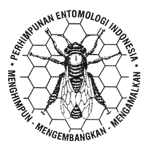Potensi serangga pengunjung bunga sebagai vektor penyakit darah bakteri (Ralstonia solanacearum Phylotipe IV) pada pisang di Sumatera Barat
DOI:
https://doi.org/10.5994/jei.9.1.38Keywords:
blood disease bacterium, R. solanacearum Phylotype IV, insect vector, Trigona spp., Drosophila sp.Abstract
Blood diseases caused by Ralstonia solancearum Phylotype IV is a major cause of production loss of banana in Indonesia, particularly for areas in West Sumatera. Currently there is a lack of information on blood diseases. The objective of this study was to obtain data of insect diversity and its potential as a dissemination agent of R. solanacearum Phylotype IV in West Sumatera. This research was conducted with a purposive sampling method in the Tabek Panjang highlands, District of Baso, Agam Regency and Pasar Usang lowland, district of Batang Anai, Pariaman Regency, West Sumatera. The results showed that banana plants infected by R. solanacearum Phylotype IV have a high diversity of flower-visiting insects. The diversity of insects in the lowlands is higher than that in highland and mainly are dominated by Trigona spp. (Hymenoptera: Apidae), Drosophila sp. (Diptera: Drosophilidae). To test the potential of both insect as vector of the blood diseases, isolated and identification of the bacteria using triphenyl tetrazolium medium chlorid (TTC) was used. Result showed that bacteria isolated from both insect are R. solanacearum hence providing evidence of the insect as vector of the blood diseases. Both insects have the potential to be vector of R. solanacearum Phylotype IV in West Sumatera. The identification of the bacteria that causes the disease. The identification of bacteria that is spread by flower visitors insects are R.solanacearum Phylotipe IV.
Downloads
Downloads
Published
How to Cite
Issue
Section
License
Authors who publish with this journal agree to the following terms:
- Authors retain copyright and grant the journal right of first publication with the work simultaneously licensed under a Creative Commons Attribution 4.0 International License that allows others to share the work with an acknowledgement of the work's authorship and initial publication in this journal.
- Authors are able to enter into separate, additional contractual arrangements for the non-exclusive distribution of the journal's published version of the work (e.g., post it to an institutional repository or publish it in a book), with an acknowledgement of its initial publication in this journal.
- Authors are permitted and encouraged to post their work online (e.g., in institutional repositories or on their website) prior to and during the submission process, as it can lead to productive exchanges, as well as earlier and greater citation of published work (See The Effect of Open Access).








